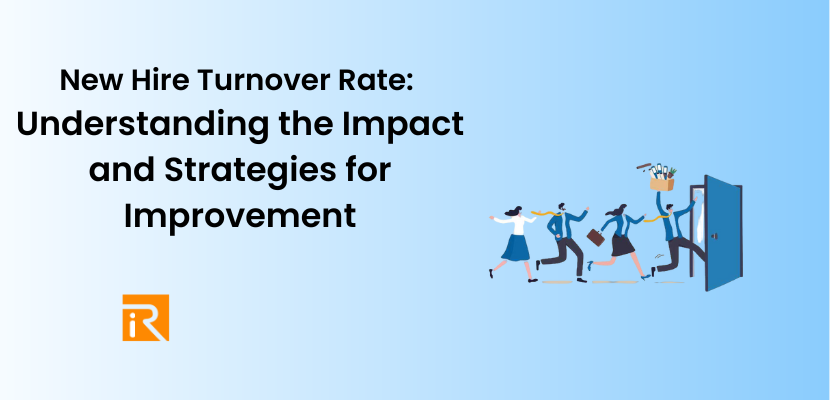In today’s competitive job market, hiring and retaining top talent is crucial for the success of any organization. However, many companies face a significant challenge in retaining their new hires. This challenge is commonly known as the New Hire Turnover Rate. In this comprehensive article, we will delve into the intricacies of the New Hire Turnover Rate, exploring its impact on businesses and providing effective strategies for improvement.
What is the New Hire Turnover Rate?
The New Hire Turnover Rate refers to the percentage of new employees who leave an organization within a specified period, typically within the first year of their employment. It is an essential metric for HR professionals and business leaders as it highlights the effectiveness of the organization’s onboarding process and its ability to engage and retain new hires.
Why is New Hire Turnover Rate Important?
Monitoring and analyzing the new hire turnover rate is essential for several reasons. Firstly, it helps identify potential flaws in the hiring process. High turnover rates among new hires may indicate that the organization is failing to attract suitable candidates or provide adequate onboarding and training. additionally, by calculating this rate, companies can uncover areas that require improvement and make informed decisions to enhance their recruitment and retention strategies.
Secondly, the new hire turnover rate impacts the overall productivity and morale of the organization. Constantly replacing employees can disrupt team dynamics, decrease productivity, and increase the workload on existing staff. Additionally, by reducing turnover rates, companies can create a more stable and productive work environment.
Steps to Calculate Your New Hire Turnover Rate
Now, let’s move on to the steps involved in calculating the new hire turnover rate.
Step 1: Define the Time Frame
To begin, you need to determine the specific time frame for which you want to calculate the new hire turnover rate. Commonly, organizations analyze turnover rates within the first year of employment. However, you can choose a different time frame based on your requirements and industry standards.
Step 2: Collect Data
Next, gather the necessary data to calculate the turnover rate. You will need information on the number of new hires during the selected time frame and the number of those hires who have left the organization within that period.
Step 3: Calculate the Turnover Rate
To calculate the new hire turnover rate, use the following formula:
New Hire Turnover Rate = (Number of New Hires who Left ÷ Total Number of New Hires) × 100
For example, if you had 50 new hires within a year, and 10 of them left the company during that time, the calculation would be as follows:
New Hire Turnover Rate = (10 ÷ 50) × 100 = 20%
This indicates that the new hire turnover rate for your organization is 20%.
Step 4: Analyze and Interpret the Results
Once you have calculated the new hire turnover rate, it’s important to analyze and interpret the findings. Compare the rate with industry benchmarks to determine how your organization fares in terms of new hire retention. Additionally, a higher turnover rate may suggest underlying issues in the hiring process, employee engagement, or training programs that need to be addressed.
Therefore, consider conducting exit interviews with departing employees to gain insights into their reasons for leaving. This information can help identify areas for improvement and guide your efforts in reducing the turnover rate.
Why Do Employees Quit?
Employee turnover is a complex phenomenon influenced by various factors. Understanding these factors is essential for employers seeking to reduce attrition rates within their organizations. Let’s explore some of the common reasons why employees quit their jobs.
Lack of Growth Opportunities
Employees are more likely to leave an organization if they feel their career progression is stagnating. When individuals feel their skills and potential are not being recognized or utilized, they may seek opportunities elsewhere. Additionally, providing employees with clear growth paths, mentorship programs, and opportunities for professional development can significantly enhance retention rates.
Inadequate Compensation and Benefits
Compensation and benefits play a vital role in employee satisfaction and retention. When employees perceive their compensation as inadequate compared to industry standards or their peers, they may be tempted to explore alternative job opportunities. Therefore, offering competitive salaries, performance-based incentives, comprehensive benefits packages, and non-monetary rewards can help retain top talent.
Poor Work-Life Balance
Maintaining a healthy work-life balance is crucial for employee well-being and job satisfaction. Long working hours, excessive workload, and a lack of flexibility can lead to burnout and employee disengagement. Employers should promote work-life balance by implementing flexible work arrangements, providing support programs, and encouraging employees to take time off to recharge.
Toxic Work Environment
A toxic work environment characterized by poor leadership, ineffective communication, and interpersonal conflicts can significantly impact employee morale and job satisfaction. Employees subjected to such environments may choose to leave in search of a healthier and more supportive workplace culture. Nurturing a positive work environment through transparent communication, strong leadership, and conflict resolution strategies can foster employee loyalty.
Limited Recognition and Appreciation
Recognition and appreciation are powerful motivators in the workplace. When employees feel their efforts and contributions go unnoticed or undervalued, they may become disenchanted and consider leaving. Employers should implement employee recognition programs, acknowledge achievements publicly, and foster a culture of appreciation to retain their top performers.
The Impact of High New Hire Turnover Rate
A high New Hire Turnover Rate can have detrimental effects on an organization, both financially and culturally. Let’s explore some of the key impacts:
Financial Implications
-
Increased Recruitment Costs
High turnover means constant recruitment efforts to fill vacant positions, leading to increased expenses in job postings, screening, interviewing, and onboarding.
-
Reduced Productivity
Constantly having to train new hires hampers productivity as employees need time to get up to speed, affecting overall organizational performance.
-
Decreased Revenue
As a result of decreased productivity and increased recruitment costs, revenue generation may suffer, impacting the company’s bottom line.
Cultural Implications
-
Low Morale
Frequent turnover can demoralize existing employees, leading to decreased job satisfaction and motivation.
-
Negative Reputation
A high turnover rate can tarnish the company’s reputation, making it challenging to attract top talent in the future.
-
Disrupted Team Dynamics
Frequent departures disrupt team dynamics and camaraderie, hindering collaboration and cohesion.
Understanding the Causes of New Hire Turnover
To effectively tackle the New Hire Turnover Rate, it is crucial to understand its underlying causes. Let’s explore some common factors contributing to high turnover among new hires:
Ineffective Onboarding Process
New employees need a structured onboarding process that helps them acclimate to their roles, understand the company culture, and establish connections with colleagues. Inadequate onboarding often leads to dissatisfaction and disengagement, prompting new hires to seek opportunities elsewhere.
Lack of Career Development Opportunities
Employees value opportunities for growth and advancement. If an organization fails to provide clear career paths, training programs, and opportunities for skill development, new hires may feel stagnant and seek greener pastures.
Poor Work-Life Balance
Maintaining a healthy work-life balance is essential for employee well-being and satisfaction. Organizations that consistently demand long working hours and fail to prioritize work-life balance may experience higher turnover rates among their new hires.
Mismatched Job Expectations
When new hires discover that their job responsibilities and expectations differ significantly from what was communicated during the hiring process, they may become disillusioned and seek alternative employment.
Strategies for Improving the New Hire Turnover Rate
Now that we have examined the impact and causes of the New Hire Turnover Rate, let’s explore some effective strategies for improving this critical metric:
-
Enhance the Onboarding Process
Invest in a comprehensive onboarding program that spans the first few months of employment. Provide new hires with the necessary tools , resources, and support to succeed in their roles. Additionally, assign mentors or buddies who can guide them and foster a sense of belonging within the organization.
-
Develop a Culture of Learning and Growth
Create a culture that values continuous learning and provides ample opportunities for employee development. Additionally, implement training programs, mentorship initiatives, and performance feedback mechanisms to help new hires enhance their skills and progress in their careers.
-
Prioritize Work-Life Balance
Promote a healthy work-life balance by encouraging employees to take breaks, providing flexible work arrangements, and recognizing and rewarding their efforts. Therefore, strive to create a supportive environment that respects personal boundaries and well-being.
-
Set Realistic Job Expectations
During the recruitment process, ensure transparency and accurately communicate job responsibilities, growth prospects, and organizational culture. Additionally, by setting realistic expectations, you can align new hires’ aspirations with the reality of their roles, reducing the likelihood of early attrition.
-
Foster Employee Engagement
Regularly seek feedback from new hires to understand their experience within the organization. Actively involve them in decision-making processes, recognize their contributions, and create opportunities for social interaction and team building. Additionally, engaged employees are more likely to stay committed to the company.
-
Monitor and Analyze Turnover Data
Track and analyze turnover data to identify patterns and trends. Use this information to uncover any recurring issues and take proactive measures to address them. Additionally, by leveraging data-driven insights, organizations can make informed decisions to improve the new hire experience.
Conclusion
Consequently, the New Hire Turnover Rate presents a significant challenge for organizations, but it also offers an opportunity for improvement. Additionally, by understanding the impact of high turnover, identifying its causes, and implementing effective strategies, businesses can enhance their new hire experience and create a more engaged and committed workforce. Therefore, prioritizing employee retention not only benefits the bottom line but also fosters a positive and thriving organizational culture.
Remember, reducing the New Hire Turnover Rate requires a holistic approach that encompasses effective onboarding, career development, work-life balance, and employee engagement. Therefore, by investing in these areas, organizations can position themselves as employers of choice and attract and retain top talent in the competitive landscape.
FAQs
Q: How is the New Hire Turnover Rate calculated?
The New Hire Turnover Rate is calculated by dividing the number of new hires who leave the organization within a specific time period by the total number of new hires during that period. So, the result is then multiplied by 100 to obtain a percentage.
Q: What is considered a high New Hire Turnover Rate?
A high New Hire Turnover Rate can vary across industries. However, as a general guideline, a rate exceeding 20% is often considered high. Also, it is essential to compare the organization’s turnover rate with industry benchmarks to gain meaningful insights.
Q: What are some indirect costs associated with high turnover?
In addition to direct costs such as recruitment expenses, indirect costs of high turnover include decreased employee morale, increased workload for existing employees, and potential disruption to client relationships.
Q: Can technology help reduce the New Hire Turnover Rate?
Yes, technology can play a vital role in reducing the New Hire Turnover Rate. HR software and onboarding platforms can streamline administrative processes, provide personalized training materials, and facilitate communication and feedback, enhancing the overall new hire experience.
Q: How long should the onboarding process last?
The duration of the onboarding process can vary depending on the complexity of the role and the organization’s specific requirements. However, a well-designed onboarding program typically spans several weeks to a few months to ensure new hires have ample time to integrate into their roles and the company culture.
Q: What are the long-term benefits of reducing the New Hire Turnover Rate?
Reducing the New Hire Turnover Rate has numerous long-term benefits. It leads to a more stable workforce, higher employee engagement, increased productivity, improved customer satisfaction, and a positive employer brand image.






















